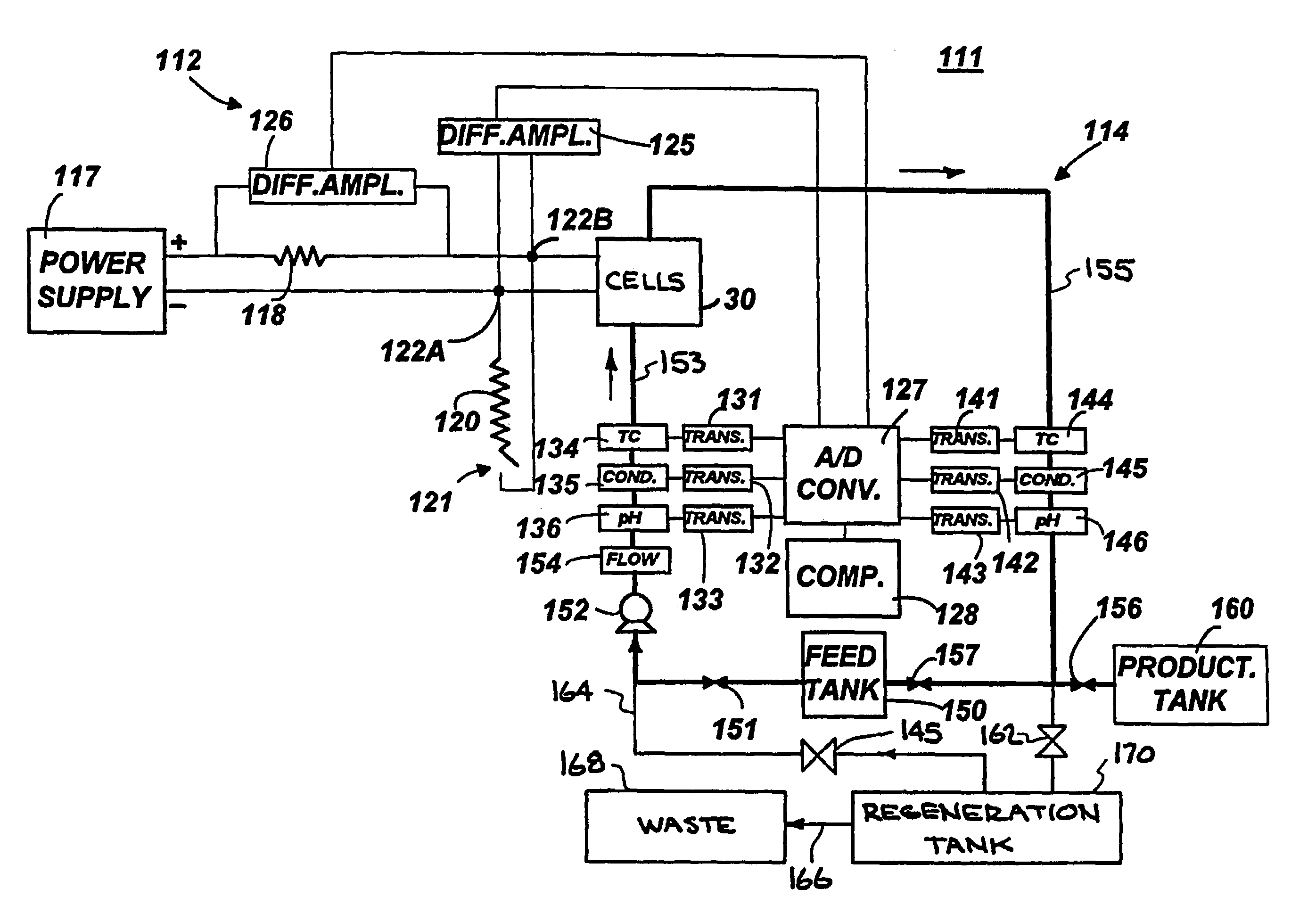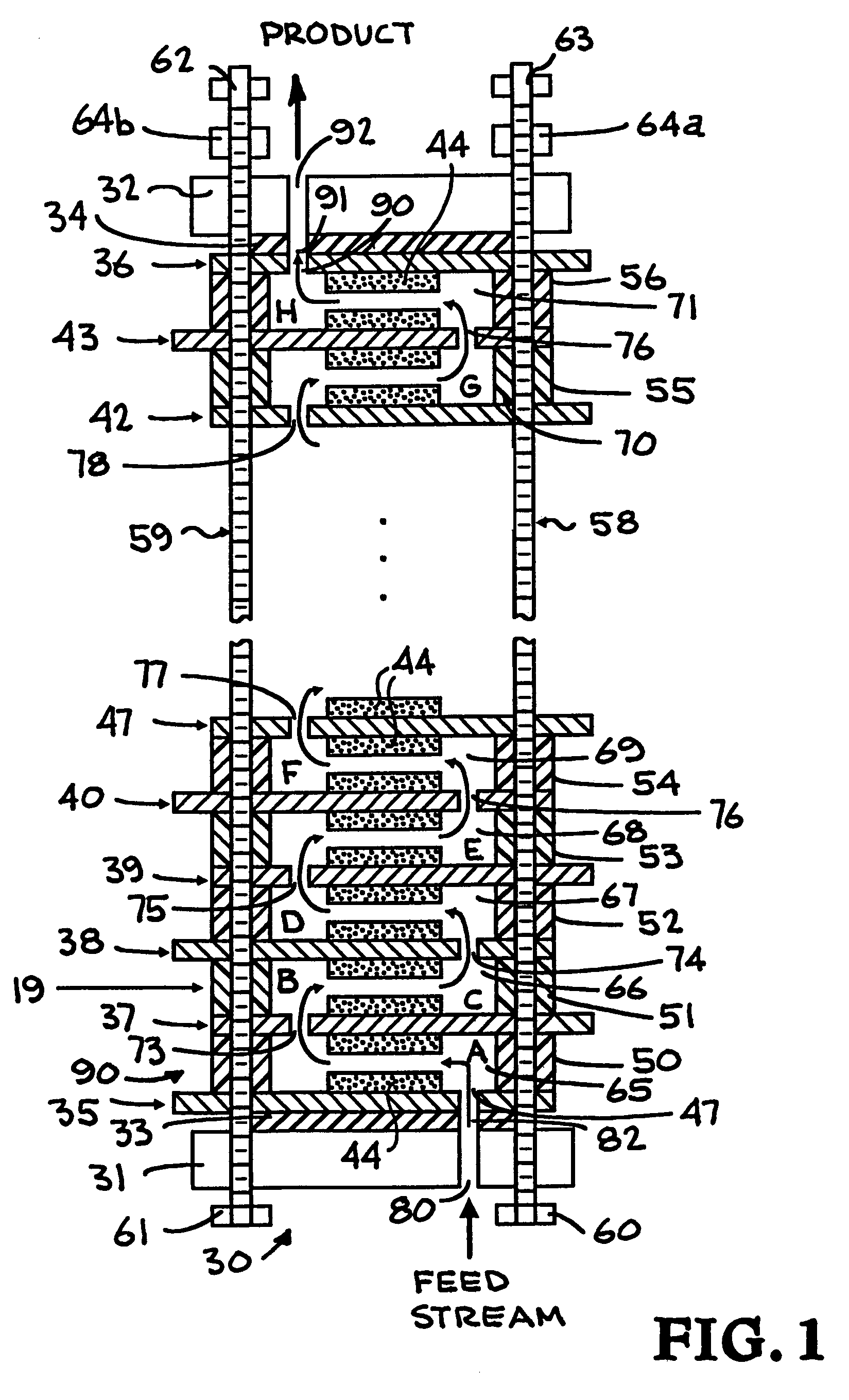Alternating-polarity operation for complete regeneration of electrochemical deionization system
a technology of electrochemical deionization system and alternating-polarity operation, which is applied in the field of electrochemical field, can solve the problems of not meeting universal commercial success or complete acceptance, generating large volumes of corrosive secondary waste, and not being completely satisfactory for specific applications or useful for all applications, etc., and achieves the effect of minimizing the total volume of waste solution, facilitating extension, and maximizing conductivity
- Summary
- Abstract
- Description
- Claims
- Application Information
AI Technical Summary
Benefits of technology
Problems solved by technology
Method used
Image
Examples
example 1
[0099]In a series of 6 runs (Runs A through F), Runs B and D are conducted to illustrate the unusual aspects of the inventive alternating polarity operation. A comparative study of the efficiency and capacity improvements of the alternating polarity system of the invention is demonstrated with respect to (1) the serpentine embodiment of the invention, i.e., Run B, (2) an improved electrode construction of the invention, i.e., Run D, and (3) a flow-through, short-path design applying the principles disclosed in U.S. Pat. Nos. 5,779,891 and 5,620,597 issued to Andelman (herein known as “Andelman”), i.e., Run E.
[0100]In a capacitive deionization-regeneration system of the invention similar to that of the serpentine system disclosed herein before (Run B) is operated over ten (Nos. 1 through 10, inclusive) cycles. Each cycle includes a deionization (purification) step and a regeneration step, and the battery of electrochemical cells similar to that in FIG. 1 has a total of 15 pair of spa...
example 2
[0112]A run of 11 consecutive deionization-regeneration cycles is conducted to illustrate an unusual aspect of the alternating polarity operation of the invention. Two electrochemical deionization-regeneration batteries of the invention similar to that of battery 30 (FIG. 1) except that each battery containing 150 pairs of electrodes are used. In this system, the entire backing surface of the carbon aerogel composite is attached to the titanium sheet by conductive epoxy (FIG. 2A). A total of 134 liters of aqueous solution containing 800 mg / liter of NaCl is inleted as the raw fluid stream. The initial conductivity of the solution is recorded at about 1250 micromhos / cm. The purified water product conductivity is intended to be 500 (or less) micromhos / cm (i.e., equivalent to about 300 or less mg NaCl / liter). Also, the total volume of the waste solution is minimized and its conductivity maximized. Each cycle includes both a deionization (purification) step and a regeneration step. Each ...
PUM
| Property | Measurement | Unit |
|---|---|---|
| voltage | aaaaa | aaaaa |
| surface area | aaaaa | aaaaa |
| pressure drop | aaaaa | aaaaa |
Abstract
Description
Claims
Application Information
 Login to View More
Login to View More - R&D
- Intellectual Property
- Life Sciences
- Materials
- Tech Scout
- Unparalleled Data Quality
- Higher Quality Content
- 60% Fewer Hallucinations
Browse by: Latest US Patents, China's latest patents, Technical Efficacy Thesaurus, Application Domain, Technology Topic, Popular Technical Reports.
© 2025 PatSnap. All rights reserved.Legal|Privacy policy|Modern Slavery Act Transparency Statement|Sitemap|About US| Contact US: help@patsnap.com



